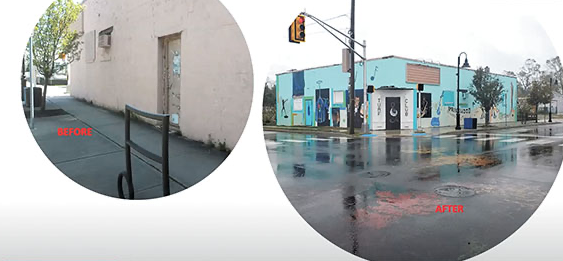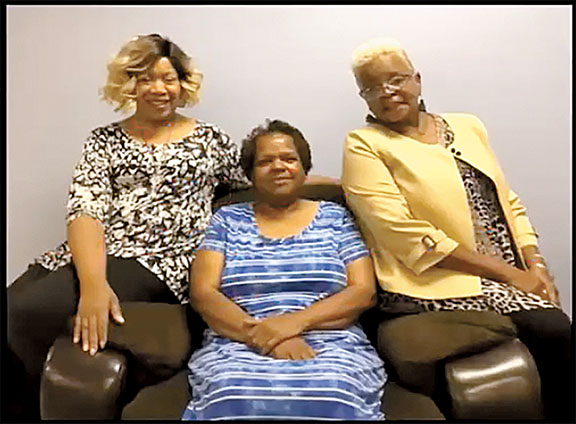
By Sunayana Prabhu
RED BANK – Three women driven by a mission to steer the progress of communities impacted by the civil unrest of the 1970s presented the latest Let’s Talk About Race program hosted by Red Bank Public library Nov. 30.
Diane Shelton, Nina Summerlin and Pamela Major helm the executive committee of Springwood Avenue Rising, the commemorative movement that acknowledges the history of an event that took place on Springwood Avenue in Asbury Park over 50 years ago. The goal of the movement is to positively engage the community and assess its needs to make future progress.
Summerlin presented a documentary at the virtual session with vintage photos of the thriving west side of Asbury Park and present-day interviews with residents who experienced the civil unrest. Since most of the public record of the riots is based on a variety of firsthand accounts, it lacks consistency, Shelton said. During their research, the Springwood Avenue Rising members found that “it depended on who was being interviewed and who was doing the writing, whether the July occurrence of 1970 was referred to as a riot, a revolt or civil unrest.”
According to Princeton University’s report on the Springwood Avenue Rising, written by Vayne Ong, “the Asbury Park, NJ ‘riot,’ occurring between July 4 and July 11, 1970, resulted in 180 injuries, 167 arrests, and $4 million in property damage. The damages were largely concentrated on Springwood Avenue, the main commercial thoroughfare of the city’s African American residential and business district called the ‘west side.’ ”

As Summerlin’s narration in the documentary faded, a mix of residents spoke directly to the camera:
“There was a lot to do down on Springwood before 1970, it was a lot of fun. You will see women and men who had a lot of pride walking through this area.”
“Post-riot, there were some missed opportunities to, like, revitalize this side of town and to help keep families here, and us, as well.”
“We still don’t have local shops, where local businesses are and I’m not saying that every business down it (Springwood Avenue) was all Black, because it wasn’t.”
According to Shelton, the west side had a proud heritage from the 1920s to the time of the civil unrest. In 1970 there were shoe and clothing stores, barber shops and restaurants and clubs lining the commercial quarter hosting jazz, blues, soul, R&B, rock ‘n’ roll music. “The music stage was the one place where race didn’t seem to matter,” said Shelton.
In 2019, Shelton, Summerlin and Major came together to discuss ideas for the approaching 50th anniversary of the rising. A Springwood Avenue steering committee evolved with 20 to 25 members. From there, the vision was born, and a tagline and mission created comprised of four Ps; People, Progress, Purpose and Pride. Through community planning and cooperative efforts, the 50th commemorative anniversary would recount history by honoring and paying tribute to residents and commemorating former businesses that once occupied Springwood Avenue until 1970.
Left desolate post riots in 1970, the present-day revitalization of Springwood Avenue started around 2013. In 2012, Interfaith Neighbors, a nonprofit based in Asbury Park, partnered with the city of Asbury Park to construct and open the Springwood Center, which sits on the corner of Springwood and Atkins avenues. “Just imagine, that’s 42 years,” Shelton said. “It was the first commercial construction along the west side commercial corridor since 1970.”
The Springwood Avenue Rising committee, in collaboration with individuals and nonprofit and government agencies, including volunteer residents, the fire department, Interfaith Neighbors and Habitat For Humanity, pushes for the revitalization of the west side, especially along Springwood Avenue.
In one example, the Turf Club, with cracked and peeling paint, was turned into a mural project with the support of Interfaith Neighbors. “You don’t know what effect that had on the community. People were stopping to take part in paintings,” Shelton said, noting a Wells Fargo Regional Foundation implementation grant allowed them to produce five murals on the west side. The most appealing part, Shelton said, “is the partnership that we actually see.”
To make up for all the projects derailed due to the pandemic, Major said Springwood Avenue Rising has lined up a lot of events on topics like preserving history, the presence of men and the power of community.
During public comments, Tim Zebo, a member of the Unitarian congregation in Lincroft, asked how the Springwood Avenue Rising committee measures success in terms of the number of new Black businesses and involvement of Black men in their projects. Major responded by saying one of the ways progress can be measured is through the lives of children who deal with fathers who are not present. She said with the addition of men in their projects, they will be “more present in the community, we will see that play out in the lives of the children.”
One employee of the Red Bank Public Library discussed the dynamic on the east versus west sides of Red Bank, drawing a comparison to Asbury Park’s Cookman Avenue – where development is thriving – to Springwood Avenue. “What kind of communication and cooperation is going on between all the different entities and how are these things benefiting the community at large?” she asked.
Major agreed that “railroad tracks have been separating people for hundreds of years.” She noted that the Mayor’s Wellness Committee in Asbury Park is launching a year-long, stigma-free initiative which involves residents to champion healthy and active living within the City of Asbury Park and improve overall health within the community. “But the first change is to get people talking to one another,” Major said.
Let’s Talk About Race is a series of programs the Red Bank Public Library began over eight years ago in an effort to expand dialogue and understanding between people of various races, religions and ethnic backgrounds in the greater Red Bank community. In 2018, this program won the New Jersey State Library’s Multicultural Award. The Let’s Talk About Race program has made the library a leader in diversity education and positioned it at the forefront of cultural conversation.
The article originally appeared in the December 8 – 14, 2022 print edition of The Two River Times.














